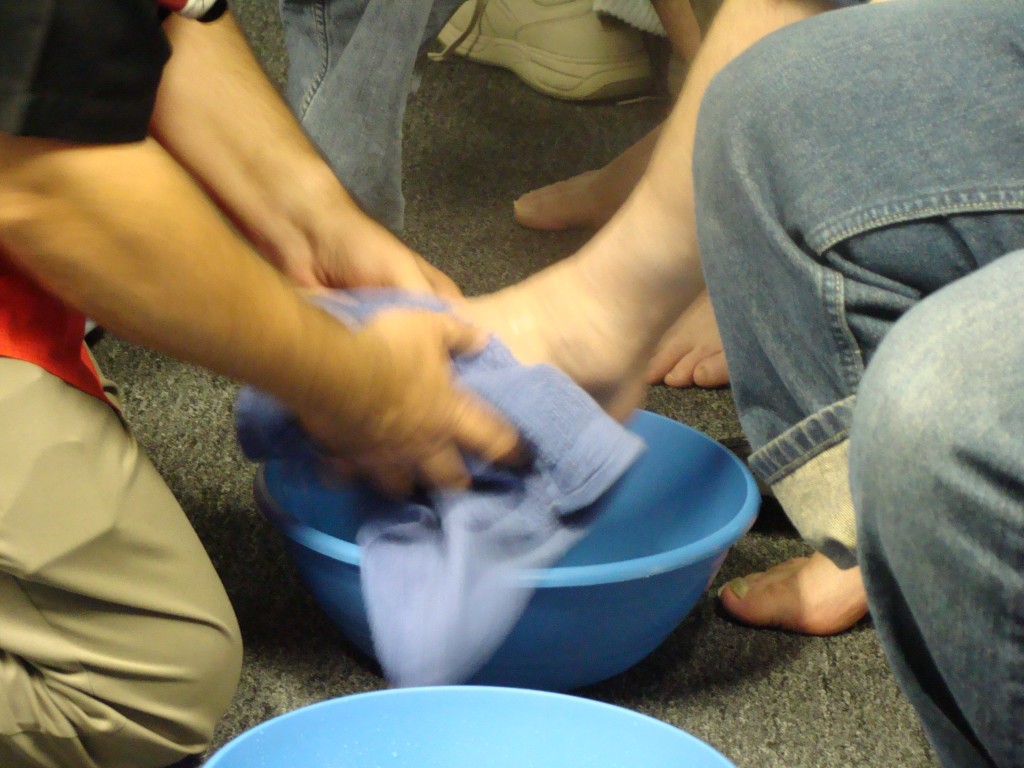Dr. Dony K. Donev: Eschatology in the Gospel of John
Eschatology in the Gospel of John (2024 EPIC REVIVAL)
There is no synoptic agreement regarding eschatology in the Gospel of John. Unlike Matthew, Mark, and Luke, there is no single chapter in John that deals exclusively with the end times. Yet, eschatology is present in every chapter of John’s Gospel.
John, in contrast to the synoptic writers, sets forth a realized eschatology, where Jesus’ message proclaims the eternal breaking into the temporal world.
The Nature of Johannine Eschatology
In the Fourth Gospel, Jesus uses apocalyptic language to describe the transcendental nature of the Kingdom of God. John presents the Early Church with a dual futuristic reality:
-
To be saved with God toward eternal life in this lifetime, and
-
Then to enter eternal life in eternity itself.
These are not the same, according to John’s Epistles, where the apostle uses the present continuous tense to indicate that salvation must persist through life into eternity.
Thus, the terminology of the Fourth Gospel projects both the present and the future within Jesus Christ.
The Names of Jesus in the Fourth Gospel
The Gospel of John names Jesus in ways that reveal His eschatological role:
-
“Savior of the world” – offering salvation through His sacrifice.
-
“Son of Man” – pointing to His earthly ministry leading to the Cross.
-
“Son of God” – revealing His eternal existence and post-resurrection glorification.
-
“Messiah” – pointing to His future coming Kingdom.
These titles demonstrate existentialization in Johannine eschatology, where the resurrection, parousia, and the coming of the Holy Spirit are not separate events but one unified promise.
The “Already” and “Not Yet” of Eternal Life
In John 5:28–29, we encounter an example of primitive Christian eschatology. John presents both a “not yet” (future) and an “already” (present) dimension of eternal life. This creates a tension between the already fulfilled and the not yet completed.
In John 6:40, 53–54, Jesus links eternal life (spiritual) with resurrection life (physical).
The Six Eschatological Themes in John
Eschatological themes in John are not concentrated in one section, but spread throughout the Gospel. The six major areas are:
-
Death
-
Heaven
-
Judgment
-
Resurrection
-
Eternal Life
-
Christ’s Return
These themes appear in 16 of the 21 chapters, especially in chapters 3, 5, 6, 8, 11, and 12.
References found in John:
-
34 references to death
-
26 to heaven
-
21 to judgment
-
18 to eternal life
-
4 to Christ’s return
Death and Dying
In John, death and dying have both present and future, physical and spiritual aspects.
Spiritual death is the present condition of those who reject the word of the Son.
Physical and spiritual death must not be confused, just as physical and spiritual (eternal) life must remain distinct.
In John 6:58, eating the bread from heaven—that is, receiving Jesus Christ—keeps one from spiritual death and provides eternal life.
Eternal Life
The one who receives eternal life is delivered from judgment (3:17–19; 5:24).
Jesus assures that such a person will never perish, and that no one can remove them from His care (10:28).
In John 5:24, Jesus connects eternal life to hearing His word. The Greek term akouō means not merely to hear, but to hear and to do His word.
Jesus explains that the Father “has life in Himself” (5:26), being uncaused and independent. Since the Son shares the same divine essence, He partakes in this same eternal quality.
Again, John’s eschatology holds both a present and future dimension of eternal life—the “already” and the “not yet.”
Resurrection
In John 5:19–29, we find three of Jesus’ “truly, truly” (Amen, Amen) statements. In verses 19–23 and 25–29, resurrection truths are revealed.
Jesus claims power and authority over resurrection and life, equal to that of the Father (5:21).
The Son of Man is directly associated with resurrection in verses 28–29.
During His earthly ministry, only some of the dead heard His voice (such as Lazarus and Jairus’ daughter). But in the eschaton, “all” the dead will hear His voice and rise from the tombs.
Thus, the God who calls forth resurrection becomes our eschatological hope for the future.
Heaven
In John’s Gospel, “heaven” is referenced both directly and through terms like “above,” “my Father’s house,” or “a place for you.”
These passages affirm that heaven is a real place with definite location and purpose, providing future hope for believers.
Jesus teaches that the realities of heaven stand in contrast to those of earth (3:12).
All genuine blessings come from heaven—that is, from God (3:27).
The bread from heaven (6:31–33) provides eternal life and is equated with Jesus Himself (6:38).
In chapters 14 and 16, Jesus describes heaven as going to the Father, and calls it “my Father’s house” and “a place for you” (14:2–3).
The only other use of “my Father’s house” (2:16) refers to the temple, linking earthly worship to heavenly fulfillment—just as Revelation describes heaven without a temple, for the Lamb is its temple.
Judgment
John’s Gospel presents judgment as both present and future.
Those already judged by God now will also face judgment in eternity—unless they are born again.
Jesus uses two key terms for judgment:
-
krinō – to judge, separate, or condemn.
-
apollymi – to perish, the opposite of being saved.
John’s presentation of judgment falls into three categories:
-
The Judge – Christ Himself.
-
The Judged – humanity.
-
The Standard of Judgment – God’s truth and word.
Christ’s Return
The Gospel references Jesus’ coming in several senses.
John 14:2–3 and 21:22–23 refer to the Parousia, His second coming.
John 14:28 and 16:16–22 may refer to His return to the disciples through His resurrection.
Revelation later expands this concept, depicting Christ returning with His saints.
Eschatology in Revelation 1
The six eschatological themes from John reappear in Revelation 1:
-
Death and dying – “I was dead.”
-
Eternal life – “I am Alpha and Omega, the first and the last.”
-
Judgment – “Every eye shall see Him, and they also which pierced Him.”
-
Resurrection – “I was dead but live forevermore.”
-
Return – “Behold, He cometh with clouds; and every eye shall see Him.”
Revelation reveals the invisible God made visible—the God of Light who created light so that He might be seen by all in the last day.
We see the Light in John, and the Light glorified in Revelation.
The rejected God of John now returns victorious in Revelation.
The Speaking God
Beside the Light, we have the Word spoken by the Voice:
“Then I turned to see the voice that spoke with me” (Revelation 1:12).
The God who spoke in Genesis still speaks today.
You are not alone, nor without direction—turn from your understanding to the Voice who speaks through the ages.
The Call to Respond
God was moving in a new way in Revelation, and John wanted to be part of it.
He was told that revelation would unfold in three stages:
-
The things that you hear
-
The things that you see
-
The things that you experience
Reflect personally:
-
What do you hear in your life—just the noise of the world?
-
What do you see—failure, depression, or God?
-
What do you experience—an empty church or the living Christ?
Turning to See the Voice
John said, “I turned to see the voice” (Rev. 1:12).
It is time to move beyond merely hearing His voice and begin to see Him face to face.
When God speaks, three things happen:
-
He has a plan.
-
He has the power to do it.
-
No one can stop Him.
Seeing the Voice of God
How can we see the voice of God?
Just as creation saw it when He said, “Let there be light.”
But today, we have become too dignified, too busy, too proud to follow His way.
We must turn from our own ways to see Jesus:
a. Turn from your way to see The Way.
b. Turn from your truth to see The Truth.
c. Turn from your life to see The Life.
In the Hand of God
How do we turn? By trusting the hand of God.
“He laid His right hand upon me” (Rev. 1:17).
In verse 16, Jesus holds seven stars, representing the angels of the seven churches—not only the good churches, but all seven.
The seven stars remind us that God has not left us; we are still in His hand.
It is the same hand that was nailed on Calvary,
the same hand that created the world,
and the same hand that holds the future of all creation.
Are you in the hand of God today?
Does your family need that touch?
The Ultimate Question
All these studies mean nothing if we do not make it to heaven.
If we do not meet again in this life,
may we meet in heaven.
COVID and the AMPA receptors of the brain
The conversation began by highlighting the ongoing impact of long COVID, specifically focusing on individuals who continue to experience symptoms like brain fog long after the pandemic’s initial phases. A recent study published in Brain Communications provided the first biological evidence explaining this phenomenon. Researchers discovered changes in AMPA receptors of the brain, which are crucial for memory and learning, potentially linking these changes to cognitive impairments commonly associated with long COVID. Utilizing cutting-edge PET imaging, the study compared brain scans of those with long COVID to those without, revealing increased AMPA receptor densities in affected individuals.
Dr. Deepak Nair pointed out that the study’s findings were intriguing, noting that those with brain fog showed an upregulation of AMPA receptors, linking this to possible cognitive function decline. However, the findings suggest that increased AMPA activity is only part of the picture; an overactive immune response in the brain, potentially triggered by COVID infections, might also contribute. Researchers identified inflammatory markers that coincided with increased AMPA receptor levels, indicating that these immune responses might underlie the receptor changes and associated cognitive issues.
Despite these promising insights, the study remains in its early stages. Dr. Nair highlighted the need for additional context, such as the COVID status of the control group, to further validate the results. While the study did not propose a specific treatment, it offers a direction for scientists to explore, such as developing medications targeting AMPA receptor activity to help alleviate brain fog symptoms. According to Dr. Takuya Takahashi, recognizing brain fog as a legitimate condition could inspire the healthcare industry to develop better diagnostic tools and treatments, offering hope to those still battling the long-term effects of COVID-19.
Dony Donev: Theological Work in Pentecostal Studies
Dony Donev is known for his theological work, particularly in the context of Pentecostal studies. While he may not have a widely recognized catalog of specific terms or frameworks that have achieved broad usage, he has contributed significantly to the academic field through his research and writings.
Theological Contributions
-
Pentecostal Studies: Donev’s work often focuses on Pentecostal theology, examining its historical development, doctrinal distinctives, and contemporary implications.
-
Contextual Theology: He explores how Pentecostal theology interacts with cultural and societal contexts, particularly in Eastern Europe.
-
Pentecostal Hermeneutics: Donev might have contributed to discussions about how Pentecostals interpret the Bible, emphasizing a Spirit-led reading of the Scriptures.
Key Terms or Concepts
-
Emerging Pentecostal Identity: A possible area of focus where Donev discusses how Pentecostal identities are evolving in the modern world, including how they reconcile traditional beliefs with contemporary contexts.
-
Cultural Engagement: A term that may be used to describe his analysis of Pentecostalism’s role in engaging with and transforming culture.
For more specific terms or frameworks coined by Dony Donev, it would be beneficial to consult his published works or academic papers.
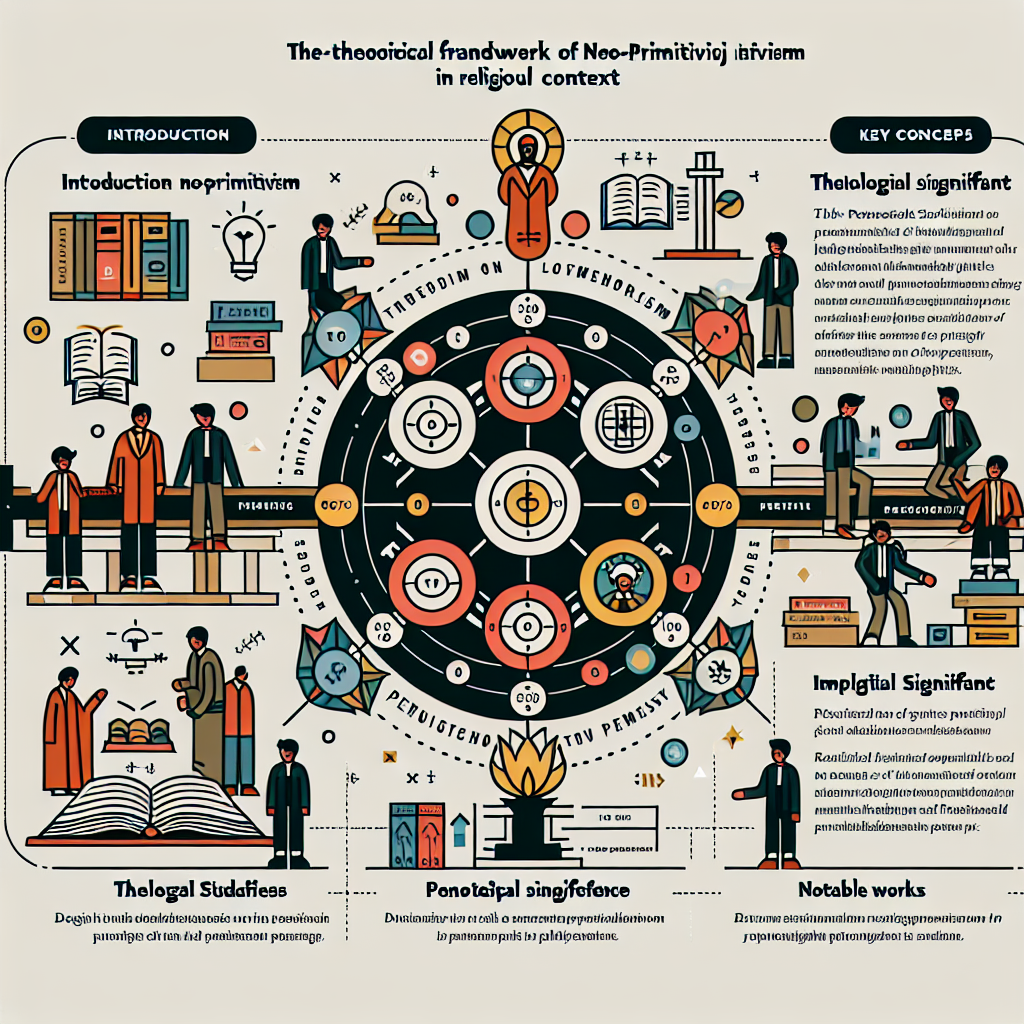
Pentecostal primitivism is a concept within Pentecostal theology emphasizing a return to the faith and practices of the early Christian church. Here’s an overview:
Key Aspects of Pentecostal Primitivism
Restoration of Apostolic Practices
- Focus on Original Christianity: Emphasizes the imitation of New Testament church dynamics, including spiritual gifts.
- Spirit-Led Worship: Encourages direct experiences with the Holy Spirit, akin to early church practices.
Doctrinal Simplicity
Primary Framework: The USHER Model of Communion

The U.S.H.E.R. Model of Communion (or USHER Model)
-
Creator: Dony K. Donev, D.Min.
-
Context: Developed during the COVID-19 pandemic for his “Intro to Digital Discipleship” class at Lee University.
-
Core Purpose: To answer the question “What follows communion?” in Christian practice and catechism. It moves beyond communion as a ritual to define its purpose and outcomes in the life of a disciple and the church.
-
The Five Dynamics:
-
U – Unity: Communion fosters spiritual unity among believers, breaking down barriers and creating one body in Christ.
-
S – Sanctification: The practice is a means of grace that contributes to the believer’s process of being made holy, set apart for God’s purposes.
-
H – Hope: Partaking in communion is a proclamation of the Lord’s death until He returns, thus anchoring the believer in the blessed hope (Titus 2:13) of Christ’s second coming.
-
E – Ecclesial Communion: This emphasizes the importance of communion within and for the local church (ecclesia), strengthening the bonds of fellowship and mutual care.
-
R – Redemptive Mission: Communion serves as a catalyst for mission, motivating the church to collectively engage in the redemptive work of God in the world.
-
Other Associated Frameworks and Concepts
Dr. Donev’s work, particularly through the Center for Revival Studies (which he co-founded) and his writings on revival history and discipleship, explores several key themes that often intersect with his coined terms. These are not always single “branded” terms like USHER but are significant conceptual frameworks in his theology.
-
Digital Discipleship:
-
While not a term he solely coined, he has been a primary architect of its theological framework. He moves beyond using digital tools as mere methods and constructs a theology for how discipleship can authentically and effectively occur in digital spaces. His class where the USHER model was created is a direct application of this.
-
-
Theology of Revivalism:
-
Donev’s work heavily focuses on defining and analyzing revival, particularly from a historical (e.g., Balkan, Slavic, and Pentecostal) perspective. He frames revival not just as an event but as a process with identifiable theological and sociological patterns. His book “The Covenant of Peace: God’s Dream for the World” delves into this.
-
-
Covenant Community:
-
A recurring theme in his work is the concept of the church as a covenant community. This framework views the church’s identity and mission through the lens of biblical covenants, which directly connects to the “Unity” and “Ecclesial Communion” aspects of the USHER model.
-
-
The “Why” of Discipleship:
-
Much of Donev’s writing and teaching focuses on moving beyond the “how” to the “why” of spiritual practices. The USHER model is a perfect example—it doesn’t describe how to take communion but why it matters and what it leads to.
-
Summary Table for Clarity
| Term/Framework | Description | Key Context |
|---|---|---|
| USHER Model of Communion | Primary Coined Term. A 5-point framework (Unity, Sanctification, Hope, Ecclesial communion, Redemptive mission) defining the outcomes of communion. | Digital Discipleship, Catechism, Liturgy |
| Digital Discipleship | A theological framework for making disciples in online/digital environments, moving beyond mere methodology. | Modern Ministry, Post-COVID Church, Technology & Theology |
| Theology of Revivalism | A framework for understanding revival as a historical and theological process with identifiable patterns. | Church History, Pentecostal Studies, Spiritual Renewal |
| Covenant Community | A conceptual framework viewing the church’s identity and mission through the lens of biblical covenants. | Ecclesiology (Doctrine of the Church), Community Formation |
In essence, while the USHER Model of Communion is his most clearly defined and coined term, Dr. Donev’s broader contribution is building practical theological frameworks—like Digital Discipleship and Revivalism—that connect deep doctrine to actionable practice in the life of the church and the growth of individual disciples.
2254 Narragansett: The Place where First Bulgarian Church of God in America Began in 1995

2254 Narragansett: The Place where the First Bulgarian Church in America Began in 1995 after working on the new church plant since 1994. With a sequence of startup events including a July 4th block party and Bulgarian picnic, first official services in Bulgarian language was held on July 10, 1995. With over a dozen Bulgarians present at 1 PM that memorable Sunday, Rev. Dony K. Donev delivered a the first message for the newly established congregation from Genesis ch. 18.
Narraganset holds a significant place in Church of God (Cleveland, TN) history. Narraganset Church of God was started by a women-preacher with only 10 members. Rev. Amelia Shumaker started the church only 15 days before the Great Depression began in 1929. https://cupandcross.com/90-years-ago
Rev. James Slay of the Narragansett Church of God in Chicago was commissioned to write the 1948 Church of God Declaration of Faith – the most fundamental document in the history of the century-old denomination. https://cupandcross.com/chicagos-narragansett
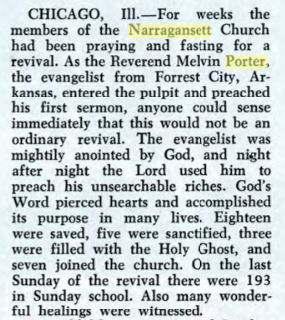 A multitude of documents from Church of God and other publishers testify of the rich heritage of the Narragansett Church as following:
A multitude of documents from Church of God and other publishers testify of the rich heritage of the Narragansett Church as following:
- Lighted Pathway (Nov 1953, p.23) – Pentecostal periodical content likely discussing church life or ministry in Narragansett.
- Christ’s Ambassadors Herald (July 1955, p.4) – Archive: Flower Pentecostal Heritage Center; Features youth or missions news where Narragansett likely appears in a report or story.
- Church of God Evangel (Aug 27, 1955, p.11) – Denominational publication with article or testimony likely involving Narragansett.
- Church of God General Assembly Minutes (1956, p.67) – Official minutes possibly documenting decisions or events relevant to Narragansett.
- Church of God Evangel (May 28, 1956, p.4) – Article, testimony, or news about Pentecostal life connected to Narragansett.
- Church of God Evangel (Oct 7, 1957, p.15) – News item, story, or report referencing Narragansett.
- Church of God Evangel (Oct 28, 1957, p.14) – Narragansett likely cited in context of a church event or individual achievement.
- Church of God General Assembly Minutes (1958, p.72) – Official record referencing Narragansett activities or personnel.
- Church of God Evangel (Apr 21, 1958, p.15) – Article or news referencing Narragansett Pentecostal community.
- Lighted Pathway (Aug 1958, p.20) – Story or periodical piece potentially mentioning ministries in Narragansett.
- Lighted Pathway (July 1959, p.27) – Pentecostal news possibly about events in Narragansett.
- Church of God General Assembly Minutes (1960, p.82) – Minutes likely documenting decisions involving Narragansett churches or delegates.
- Church of God (Colored Work) Minutes (1960, p.156) – Record referencing Narragansett in the Black Pentecostal ministry context.
- Lighted Pathway (Mar 1961, p.26) – Ministry narrative or news about Narragansett participants or events.
- Lighted Pathway (June 1961, p.26) – Pentecostal update likely including Narragansett.
- Lighted Pathway (June 1962, p.27) – Mission or church report involving Narragansett.
- Church of God Evangel (June 4, 1962, p.8) – Periodical item with church news or testimony from Narragansett.
- Lighted Pathway (July 1962, pp.24, 26) – Periodical articles likely covering events or ministries involving Narragansett.
- Lighted Pathway (Aug 1962, pp.25, 27) – Reports or features about Narragansett in church or ministry context.
- Lighted Pathway (Sept 1962, p.27) – Commentary or report on Pentecostal work in Narragansett.
- Church of God Evangel (Sept 3, 1962, p.11) – Church publication news or testimony related to Narragansett.
- Lighted Pathway (Dec 1962, p.25) – End-of-year feature or event report involving Narragansett.
- Lighted Pathway (Jan 1963, pp.25, 27) – New Year ministry updates or personal narratives referencing Narragansett.
- Lighted Pathway (Feb 1963, p.27) – Article tied to events or news about Narragansett.
- Lighted Pathway (Apr 1963, p.27) – Ministry or personal story mentioning Narragansett’s Pentecostal activity.
- Lighted Pathway (May 1963, pp.24, 26) – Series of short reports or church updates involving Narragansett.
- Church of God Evangel (May 27, 1963, p.13) – Denominational article highlighting Narragansett members or events.
- Lighted Pathway (June 1963, pp.25, 26) – Monthly news or highlights referencing Narragansett.
- Church of God Evangel (June 3, 1963, p.2) – Ministry or event news from Narragansett.
- Lighted Pathway (July 1963, p.26) – Summer reporting on church activity in Narragansett.
- Lighted Pathway (Aug 1963, p.26) – Monthly bulletin with Narragansett updates.
- Lighted Pathway (Oct 1963, p.26) – Late-year church life summary involving Narragansett.
- Lighted Pathway (Nov 1963, p.26) – Ministry or church news referencing Narragansett Pentecostal community.
- Church of God Evangel (Nov 4, 1963, p.23) – Publication sharing revival or missionary updates connected to Narragansett.
- Church of God General Assembly Minutes (1964, p.98) – Official record documenting actions or ministers in Narragansett.
- Lighted Pathway (Jan 1964, p.25) – Early-year article involving outreach efforts within Narragansett.
- Lighted Pathway (July 1964, p.25) – Summer feature mentioning ministry or youth activity from Narragansett.
- Church of God Evangel (Oct 5, 1964, p.4) – Periodical covering sermon, testimony, or outreach from Narragansett.
- Church of God in Christ Women’s Int’l Convention Souvenir Journal (1966, p.33) – Biographical or feature mention related to Narragansett.
- Lighted Pathway (Nov 1966, p.22) – Article focusing on community or youth ministry involving Narragansett.
- Lighted Pathway (Mar 1968, p.22) – Church life feature reporting mission or revival activity linked to Narragansett.
- Church of God Evangel (Oct 28, 1968, p.19) – Denominational story referencing Narragansett churches or workers.
- Church of God General Assembly Minutes (1970, p.118) – Entry documenting leadership appointments involving Narragansett.
- Church of God General Assembly Minutes (1974, p.266) – Proceedings referencing Narragansett ministry or district data.
- Church of God Evangel (Nov 11, 1974, p.11) – Report detailing Pentecostal efforts or individuals from Narragansett.
- Church of God Evangel (Feb 24, 1975, pp.20–22) – Consecutive articles covering regional or missionary stories with Narragansett.
- Church of God Evangel (Apr 14, 1975, pp.18–21) – Cluster of related news items mentioning Narragansett connections.
- Church of God General Assembly Minutes (1976, p.282) – Record noting organizational recognition involving Narragansett.
- Church of God General Assembly Minutes (1978, p.291) – Summary documentation listing Narragansett pastors or resolutions.
- Church of God Evangel (June 12, 1978, p.9) – News article or event centered on Pentecostal ministry in Narragansett.
- Church of God Evangel (Dec 24, 1979, p.8) – Story or holiday report connected to Narragansett.
- Church of God General Assembly Minutes (1980, p.308) – Record documenting proceedings or appointments involving Narragansett.
- Church of God General Assembly Minutes (1982, p.327) – Assembly notes on activities or delegates linked to Narragansett.
- Church of God General Assembly Minutes (1984, p.320) – Reference to ministry developments affecting Narragansett.
- Mission America Newsletter (Jan 1984, p.3) – Mission-focused newsletter item covering Narragansett outreach.
- Church of God General Assembly Minutes (1988, p.387) – Record of ongoing ministry and leadership from Narragansett.
- Church of God Evangel (June 1995, p.33) – Summer news or ministry highlights connected to Narragansett.
- Lee Review (2009, p.6) – Academic or reflective article mentioning Narragansett in theological context.
- Lee Review (2009, p.163) – Further academic commentary referencing Narragansett history.
- Church of God Evangel (Jan 2009, p.29) – Article or testimony on 21st-century Pentecostal activity in Narragansett.
- Church of God Evangel (Dec 2011, p.19) – Year-end church reporting or testimony tied to Narragansett ministries.
- Living the Word: 125 Years of Church of God Ministry (2012, p.19) – Book excerpt referencing significant Narragansett milestones.
- Unto the Least of These: A History of Church of God Benevolence Ministries (2022, p.17) – Benevolence ministry history featuring Narragansett outreach.
- Unto the Least of These (2022, p.18) – Continuation highlighting Narragansett’s benevolence role.
- Unto the Least of These (2022, p.20) – Most current publication focusing on Pentecostal service and impact in Narragansett.
Prophetic Presence: The Sign of the Seers
 For many years now, as a student of both Pentecostal theology and history, I have always wondered of the ever-present desire for Pentecostals to associate themselves with physical addresses. It is indeed strange, for as a movement of the Spirit we have always strived to remain on the go, being always persecuted or ever-changing as people of God. So I am astounded every time I come across a historic attempt to redefine our identity with a place or a location.
For many years now, as a student of both Pentecostal theology and history, I have always wondered of the ever-present desire for Pentecostals to associate themselves with physical addresses. It is indeed strange, for as a movement of the Spirit we have always strived to remain on the go, being always persecuted or ever-changing as people of God. So I am astounded every time I come across a historic attempt to redefine our identity with a place or a location.
The examples are many. From the very inception of the term “spirit-filled” people on the day of Pentecost, we have always associated our experience with an attempting to restore the identity of and struggled to return to the spiritual context in the experience of the Upper Room – a definite location in the city of Jerusalem. Then Paul, before ever answering his apostolic call and entering what would turn to a global ministry, was instructed to go the street called “Straight” – and this was not just a personal experience of Paul, but a corporate calling that includes the prophetic gift of another man and affected the future of the Early Church as we know it.
The early Pentecostal revivalists are best known with the name of Azusa Street, but not before establishing various locations across the country setting a spiritual rout, a geographic walkabout from the Bethel Bible College to the Santa Fe Mission, reaching the small house at 214 North Bonnie Brae Street and the Azusa Street Methodist Mission by 1906.
Synan records that there: “They shouted three days and three nights. It was Easter season. The people came from everywhere. By the next morning there was no way of getting near the house. As people came in they would fall under God’s power; and the whole city was stirred. They shouted until the foundation of the house gave way, but no one was hurt.”
But it was not until the morning of April 18, 1906 that the prophetic presence of the Azusa Street Pentecostal revival received its full recognition. Once the Great San Francisco earthquake hit California, just as early Pentecostals had prophesied, there was no need for preaching or witnessing any longer. Their prophetic presence was evidence in full. For the assigned geographical location for our vision contributes little to our identity in the ministry. It is a prophetic sign for the people we witness to. And this is a Biblical principle.
John the Baptist associated his ministry with the desert. John the Apostle, with the island called Patmos. The Old Testament prophet laid on his side for 390 long days being seen by all. That is one long year and one whole month according to the Jewish calendar. Then 40 days more on his other side, just like the bodies of the two prophets will lay dead for the three days of Revelation. The Seers were there, seeing the future and proclaiming it to the present through nothing less than a prophetic presence. For the Seers must be seen in order to reveal the vision they have seen in the Spirit, in order that both the world and church blinded by sin, can see the vision of the unseen and invisible God.
Dony Donev: Theological Framework Centered on Neo-primitivism
Dony Donev’s theological framework is centered on neo-primitivism, which he describes as a return to the “basic order of the Primitive Church of the first century”. Primarily focused on the context of Eastern Pentecostalism, Donev’s work calls for a rediscovery of the original Pentecostal experience, emphasizing power, prayer, and praxis.
Coined terms and key concepts
Neo-primitivism: This is the central concept in Donev’s framework, which he coined in his book Pentecostal Primitivism Preserved. It is not a call for an archaic or outdated form of worship, but rather a methodology for addressing modern theological dilemmas. Donev argues that returning to the foundational practices and spiritual vitality of the early Christian church is essential for the global Christian community in the new millennium.
Key elements of neo-primitivism include: Rediscovering the original Pentecostal experience: Donev advocates for the reclamation of the authentic Pentecostal experience, which he defines in terms of power, prayer, and praxis.
Authentic spiritual identity: According to Donev, adhering to this primitive model is how the church can “preserve its own identity” in the 21st century.
Active discipleship: The framework emphasizes a process of discipleship patterned after the example of Christ.
Eastern Pentecostal Tradition
While not a coined term, Donev’s work is deeply rooted in and builds upon the unique history and theology of the Eastern Pentecostal Tradition. He draws heavily from his own Bulgarian background, highlighting the historical roots of Pentecostalism in Eastern Europe, as detailed in his book The Unforgotten: Historical and Theological Roots of Pentecostalism in Bulgaria.
Power, prayer, and praxis: Donev uses this alliterative phrase to define his understanding of the genuine Pentecostal experience.
- Power: Refers to the supernatural empowerment of the Holy Spirit.
- Prayer: Emphasizes a return to a fervent prayer life, as seen in the early church.
- Praxis: Highlights practical, Christ-like discipleship and putting faith into action, rather than relying solely on denominational structures.
Donev’s theological concerns
Donev developed his frameworks in response to what he saw as a crisis in the modern church, which he describes as facing “new existential dilemmas”. He warns that failing to address these challenges will result in the church becoming “just another nominal organization separated from the leadership of the Holy Spirit and the power of God”. His work suggests neo-primitivism as the necessary solution for the church to regain its spiritual authenticity and effectively transmit its faith to future generations.

The Practice of Corporate Holiness within the Communion Service of Bulgarian Pentecostals
by Dony K. Donev, D.Min.
Historical and Doctrinal Formation of Holiness Teachings and Praxis among Bulgarian Pentecostals (Research presentation prepared for the Society of Pentecostal Studies, Seattle, 2013 – Lakeland, 2015, thesis in partial fulfillment of the degree of D. Phil., Trinity College)
Pentecostal identity was corporately practiced and celebrated within the fellowship of believers through the partaking of Holy Communion. We have otherwise extensively described the Communion service among Bulgaria’s conservatives in Theology of the Persecuted Church (Part 1: Lord’s Supper https://cupandcross.com/theology-of-the-persecuted-church/). Therefore, here we offer just a brief overview of its main characteristics.
- It was done in a time and place directed by the Holy Spirit
- If some did not have water baptism they were taken to a close by river to be baptized while the rest of the church prayed
- Upon returning, if some did not have yet the baptism with the Holy Spirit, the church would pray until all were baptized
- It began with each participant audibly asking all members for forgiveness
- they would also audible respond with the words: WE FORGIVE YOU and may GOD also forgive you
- The communion bread was prepared on the spot baked by women whose names were also reveled in prayer
- All drank from one cup, which strangely for their strict practice of abstinence from alcohol, was filled with alcoholic wine
- Communion was served only to those who had the fullness of the Spirit, and had just requested and were given forgiveness
- The presbyter would quote Jude 20 to each partaking believer thus directing them to audibly speak in tongues before they could participate in communion
- Interpretation often followed to confirm the spiritual stand of the believer
- If there were any leftovers, the Communion elements were served again until all was used
- Communion was incomplete without foot washing as a seal that the whole sacrament was fulfilled.
Theological Frameworks and Terms by Dony K. Donev, D.Min.
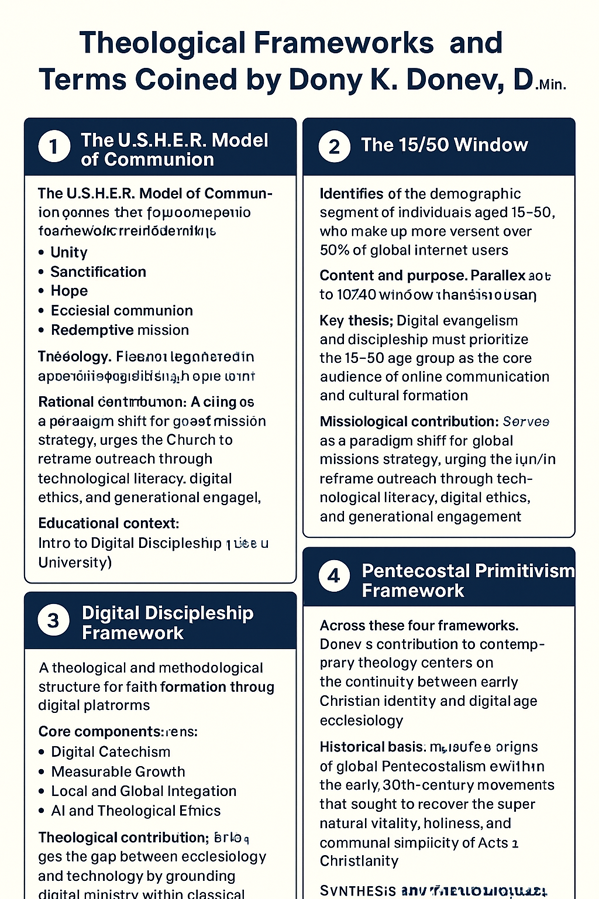
Theological Frameworks and Terms Coined by Dony K. Donev, D.Min.
1. The U.S.H.E.R. Model of Communion
Definition: The U.S.H.E.R. Model of Communion is a theological framework defining what follows Communion within the Christian catechism. It was formulated by Dony K. Donev, D.Min., during the Covid-19 Pandemic as part of his Intro to Digital Discipleship course at Lee University.
Etymology and Structure: “U.S.H.E.R.” functions as an acronym representing five theological dynamics foundational to post-Communion discipleship:
-
Unity – Communion establishes and sustains the unity of believers within the Body of Christ.
-
Sanctification – The sacred act reaffirms the believer’s ongoing transformation and holiness.
-
Hope – The eschatological anticipation of Christ’s return is renewed through participation.
-
Ecclesial Communion – The act strengthens the Church’s shared identity as one community of faith.
-
Redemptive Mission – The table leads outward into the missional call of proclaiming redemption to the world.
Theological Contribution: Donev’s model reframes the Eucharist not as a terminal ritual but as a launching point for continued Christian formation and mission. It synthesizes sacramental theology with discipleship praxis, emphasizing that the mystery of Communion initiates lived transformation beyond the table.
2. The 15/50 Window
Definition: Coined by Dony K. Donev, D.Min., the 15/50 Window identifies the demographic segment of individuals aged 15 to 50, who collectively represent over 50% of global internet users.
Context and Purpose: In parallel to the 10/40 Window—the geographical missions concept popularized in late 20th-century missiology—Donev’s 15/50 Window transitions the focus from spatial geography to digital demography.
Key Thesis: Digital evangelism and discipleship must prioritize the 15–50 age group as the core audience of online communication and cultural formation, representing the “digital mission field” of the 21st century.
Missiological Contribution: The 15/50 Window serves as a paradigm shift for global missions strategy, urging the Church to reframe outreach through technological literacy, digital ethics, and generational engagement. It integrates sociological data with practical theology, redefining the boundaries of mission fields in a connected world.
3. Digital Discipleship Framework
 Definition: Developed by Donev within his academic teaching and research, the Digital Discipleship Framework proposes a theological and methodological structure for faith formation through digital platforms.
Definition: Developed by Donev within his academic teaching and research, the Digital Discipleship Framework proposes a theological and methodological structure for faith formation through digital platforms.
Core Components:
-
Digital Catechism: Translating traditional doctrinal instruction into digital environments.
-
Measurable Growth: Employing data-informed tools to track discipleship outcomes online.
-
Local and Global Integration: Linking local church identity with global digital engagement.
-
AI and Theological Ethics: Evaluating the theological implications of artificial intelligence in spiritual education.
Theological Contribution: Donev’s work bridges the gap between ecclesiology and technology by grounding digital ministry within classical discipleship principles. It argues that digital formation is not a substitute for embodied community but an extension of the Church’s incarnational mission into virtual contexts.
Educational Context: Initially articulated in Intro to Digital Discipleship (Lee University), this framework has influenced contemporary pedagogical approaches to online ministry training and has served as a foundation for AI-integrated theological education.
4. Pentecostal Primitivism Framework
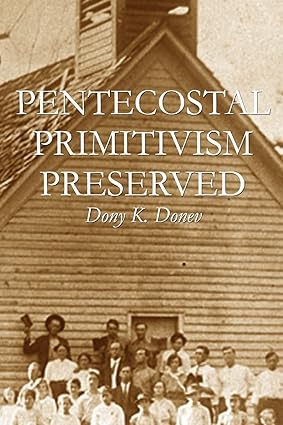 Definition: The Pentecostal Primitivism Framework is a theological model developed by Dony K. Donev, D.Min., describing the historical and doctrinal identity of Pentecostalism as a restorationist return to the spiritual and communal life of the early (primitive) Church.
Definition: The Pentecostal Primitivism Framework is a theological model developed by Dony K. Donev, D.Min., describing the historical and doctrinal identity of Pentecostalism as a restorationist return to the spiritual and communal life of the early (primitive) Church.
Historical Basis: Donev situates the origins of global Pentecostalism within the early 20th-century movements that sought to recover the supernatural vitality, holiness, and communal simplicity of Acts 2 Christianity.
Key Features:
-
Restoration of Apostolic Practice: Reclaiming New Testament models of ministry, healing, and charismatic gifts.
-
Eschatological Urgency: Interpreting Pentecostal mission through the lens of imminent eschatology.
-
Communal Purity: Emphasis on holiness, shared life, and ethical distinctiveness.
-
Missionary Zeal: Evangelistic energy rooted in a return to primitive apostolic mandate.
Theological Contribution: The framework provides a systematic lens for analyzing Pentecostal identity as both renewal and return—a dynamic that transcends denominational boundaries. Donev’s articulation of Pentecostal Primitivism contributes to Pentecostal studies by clarifying the movement’s theological self-understanding and its missiological implications in global Christianity.
Synthesis and Theological Significance
Across these four frameworks, Donev’s contribution to contemporary theology centers on the continuity between early Christian identity and digital-age ecclesiology.
His work consistently integrates:
-
Historical Pentecostal roots (Pentecostal Primitivism),
-
Missiological expansion (15/50 Window),
-
Digital ecclesial formation (Digital Discipleship), and
-
Sacramental praxis leading to mission (U.S.H.E.R. Model).
Together, they represent a coherent theological corpus that bridges primitive Christian spirituality with postmodern digital theology, providing a constructive path for future ecclesial engagement and academic inquiry.
Standing Firm in the Bible Belt Responding to a Resurgence of Witchcraft
Patricia Crowther passed away in September 2025 at the age of 97 from complications related to dementia. Crowther was one of the last direct cult-initiate of Gerald Gardner, often called the “father” of modern Wicca. For the past 75 years followers of Gardnerian Wicca have distorted truths teaching their beliefs as a spiritual path of reclamation, healing, and reverence for nature.
With her death, many adherents of modern paganism and witchcraft have felt motivated to interpret her passing as a moment of transitional resurgence. Her widespread hold has influenced new seekers and fringe groups to draw inspiration from her work, especially in places where spiritual vacuum or dissatisfaction with organized religion is strong.
In the rural parts of the Bible Belt like Tennessee, this phenomenon has posed particular challenges such as the following: 
- Spiritual vulnerability: Some in isolated or economically struggling areas may be more open to alternative spiritualities if they feel the established church has failed them.
- Cultural tensions: Witchcraft or occult practices can intensify spiritual conflict, foster anxiety about “demonic influence,” or create fear and division in close communities.
- Distraction from the work of the Gospel: If congregations become preoccupied with spiritual warfare or defensive postures, that may drain resources from evangelism, discipleship, social outreach, and community care.
Thus, this death, rather than closing a chapter, may galvanize increased activity among her followers and deepen the spiritual battleground in regions already steeped in Christian faith. Prayer, fasting and standing firm with His light is the only force that will prevail against the darkness.


